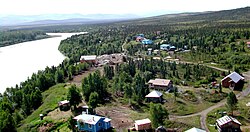Lime Village Hek'dichen Hdakaq' | |
|---|---|
 | |
 Location of Lime Village, Alaska | |
| Coordinates: 61°20′29″N155°29′27″W / 61.34139°N 155.49083°W | |
| Country | United States |
| State | Alaska |
| Census Area | Bethel |
| Government | |
| • State senator | Lyman Hoffman (D) |
| • State rep. | Bryce Edgmon (I) |
| Area | |
• Total | 78.71 sq mi (203.87 km2) |
| • Land | 76.52 sq mi (198.19 km2) |
| • Water | 2.19 sq mi (5.67 km2) |
| Population (2020) | |
• Total | 13 |
| • Density | 0.17/sq mi (0.07/km2) |
| Time zone | UTC-9 (Alaska (AKST)) |
| • Summer (DST) | UTC-8 (AKDT) |
| ZIP code | 99557 [2] |
| Area code | 907 |
| FIPS code | 02-44030 |
| GNIS ID | 2418687 [3] |

Lime (Tanaina : Hek'dichen Hdakaq') [4] is a census-designated place (CDP) in Bethel Census Area, Alaska, United States. The 2020 census found a population of 13, down from 29 in 2010. It has also been known as Hungry Village.
Contents
In July 2008, Lime Village gained notoriety [5] when it was reported that their gasoline prices were more than double of the already-high national average of over $4/gallon with Lime Village selling regular unleaded gasoline at $8.55/gallon. The high prices were considered ironic considering that Alaska is one of the main suppliers of oil in the United States, but have the highest state average due to scattered villages throughout Alaska such as Lime Village making it difficult to transport oil and other goods.
